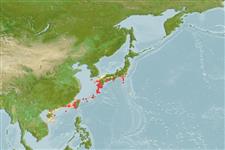Actinopterygii (ray-finned fishes) >
Perciformes (Perch-likes) >
Gobiidae (Gobies) > Gobiinae
Etymology: Priolepis: Greek, prio = to saw + Greek,lepis = scale (Ref. 45335); latifascima: From the Latin lati, meaning broad, fasc, band, and ima, end, referring to the last bar on the head which is wider than the others; noun in apposition.. More on author: Winterbottom.
Environment / Climate / Range
Ecology
Marine; reef-associated; non-migratory; depth range 0 - 5 m (Ref. 9018). Subtropical, preferred ?
Northwest Pacific: restricted to Japan and Taiwan.
Size / Weight / Age
Maturity: Lm ? range ? - ? cm
Max length : 2.1 cm SL male/unsexed; (Ref. 9018)
Dorsal
spines
(total): 7;
Dorsal
soft rays
(total): 8;
Anal
spines: 1;
Anal
soft rays: 7. No frenum, reduced scalation, lacking scales on the breast and dorsally from the top of the pectoral fin base to end of the second dorsal fin base, the opercular and pectoral bar joining at a level with the eye, with the pectoral bar 1.5-2 times wider than the opercular bar, the first to fourth dorsal spines elongate, and eight dorsal-rays.
Life cycle and mating behavior
Maturity | Reproduction | Spawning | Eggs | Fecundity | Larvae
Winterbottom, R. and M. Burridge, 1993. Revision of the species of Priolepis possessing a reduced transverse pattern of cheek papillae and no predorsal scales (Teleostei; Gobiidae). Can. J. Zool. 71:494-514. (Ref. 9018)
IUCN Red List Status (Ref. 115185)
CITES (Ref. 94142)
Not Evaluated
Threat to humans
Harmless
Human uses
More information
Common namesSynonymsMetabolismPredatorsEcotoxicologyReproductionMaturitySpawningFecundityEggsEgg development
ReferencesAquacultureAquaculture profileStrainsGeneticsAllele frequenciesHeritabilityDiseasesProcessingMass conversion
Tools
Special reports
Download XML
Internet sources
